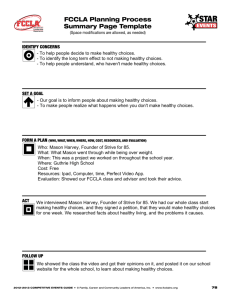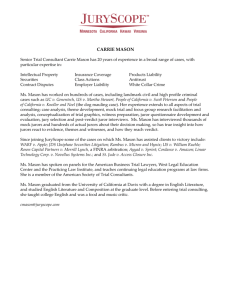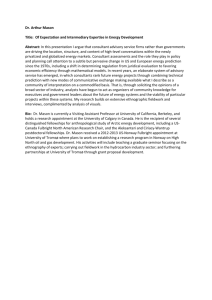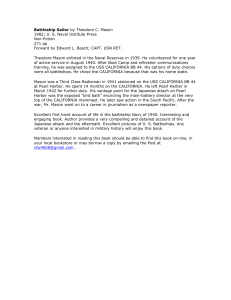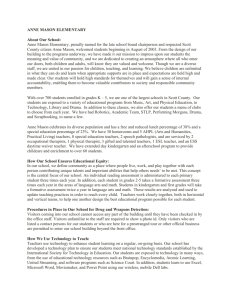Logic Models_V2 - Gregory C. Mason
advertisement
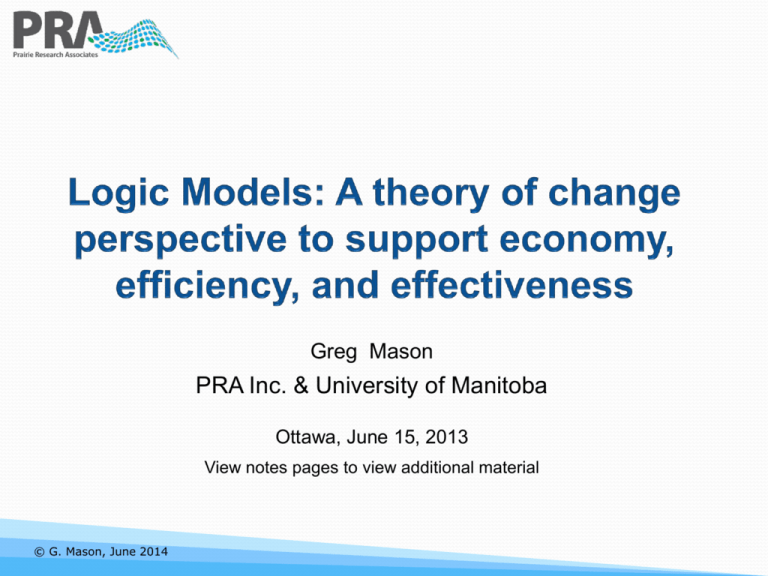
Greg Mason PRA Inc. & University of Manitoba Ottawa, June 15, 2013 View notes pages to view additional material © G. Mason, June 2014 Outline 1. Foundations – Understanding the objectives of a logic model 2. Examples of current (bad) practice 3. Goal 1 – Analysing program fidelity, economy and efficiency 4. Goal 2 – Clarifying expected impact 5. Goal 3 – Specification of the evaluation matrix © G. Mason, June 2014 2 Learning Objectives Understand the role of logic models Logic models structure the evaluation matrix Program logic clarifies impact and attribution © G. Mason, June 2014 Critically review current practice – what needs to change? Logic models frame economy/efficiency assessment 3 Part 1 - Foundations The theory of change comprises three dimensions: • design of the intervention; • implementation of the intervention; and • assessment of the impact arising from the intervention. The logic “model” must capture all these dimensions. © G. Mason, June 2014 Foundations 4 Program evaluation – a standard view PROGRAM PLANNING & DESIGN REDESIGN & RENEWAL Logic modelling often occurs …. IMPLEMENTATION MONITORING & EVALUATION © G. Mason, June 2014 Foundations 5 Program implementation & evaluation – integrated view PROGRAM PLANNING & DESIGN REDESIGN & RENEWAL EVALUATION DESIGN 1.Logic models 2.Evaluation methodology 3.Performance measures IMPLEMENTATION MONITORING & EVALUATION © G. Mason, June 2014 Foundations 6 What use are logic models? Clarify program goals (expected outcomes) ̶ relevance/rationale (policy goals/coherence) Explain program implementation ̶ design (alignment with best practice/best science) Document the project/program/initiative and its operations program fidelity – formative evaluation ̶ Support the evaluation and performance measurement system ̶ performance (accountability and impact) Communicate the essence of a program throughout the organization ̶ accountability and coordination Reveal the primary and secondary beneficiaries; the agencies/institutions responsible for the implementation; and stakeholders (the influenced and the influencers) ̶ reach © G. Mason, June 2014 Foundations 7 Role of a logic model Role 1 - Clarify program implementation Supports analysis of program fidelity ̶ Was the program implemented as intended? Identify implementation realities Define performance measures for implementation ̶ Results chain frames economy and efficiency Business process modelling Role 2 – Explain the impact in context Maps the causal logic ̶ Summarizes the theory of change, based on literature, program documentation, and management representation Defines and ranks external factors Identify contingent dependencies and multiple causality Creates method for measuring net impact ̶ ̶ Specify confounders and counterfactuals Define performance measures Role 3 – The logic model supports the evaluation matrix © G. Mason, June 2014 Foundations 8 Some examples of limited logic modelling National Child Benefit (HRDC 2003 evaluation) Agricultural Policy Framework (AAFC 2006 evaluation) Healthy Child Development – Healthy Living (First Nations and Inuit Health Branch 2013-14 evaluation) These examples reflect common practice, which underspecifies the theory of change: Program design Program interventions Program impact © G. Mason, June 2014 Foundations 9 Common deficiencies in logic modelling: implementation Logic models are “flat” and lack insight into the complexity of implementation Programs are never designed and implemented instantaneously Interaction of program elements is rarely discussed The analysis of implementation integrity or “program fidelity” is often missing © G. Mason, June 2014 Foundations 10 © G. Mason, June 2014 Foundations 11 © G. Mason, June 2014 Role 1 - Clarifying program implementation 12 Clarify program implementation • Why, what, and how? • Supports analysis of program fidelity Was the program implemented as intended? - What implementation failures occurred? - Lessons earned • Defines performance measures (implementation) - © G. Mason, June 2014 Role 1 - Clarifying program implementation 13 Example – First summative evaluation of the NCB Theory of the intervention National Child Benefit (NCB) The NCB Initiative is a joint initiative of federal and provincial/territorial governments intended to help prevent and reduce the depth of child poverty, as well as promote attachment to the workforce by ensuring that families will always be better off as a result of working. It does this through a cash benefit paid to low income families with children, a social assistance offset, and various supplementary programs (childcare, additional cash benefits, employment support, health care, etc.) provided by provinces and territories. © G. Mason, June 2014 Role 1 - Clarifying program implementation 14 National Child Benefit (two children < 18) NCB is a top-up for families with low-mid incomes Benefit Payment $6000 CCTB – Base benefit (tax free) that extends to a fairly high income (~$100,000) depending on the number of children under 18 $26,000 $33,000 All numbers approximate © G. Mason, June 2014 $100,000 Net Family Income Role 1 - Clarifying program implementation 15 Mechanism of National Child Benefit Cash transfers (Federal) Cash transfers (Provincial) Net family income PT In-kind programming Social assistance offset © G. Mason, June 2014 Role 1 - Clarifying program implementation 16 Theory of change and logic model • The logic model is much more than a static two-dimensional representation of a result chain • It comprises both symbolic explanations, text and context, and possibly an abstract (mathematical model) • The NCB “logic” shows the mechanisms for: - Reduction in the depth and incidence of child poverty …. measured by …. - Increase in net family income. • The intervention is complex • Direct cash transfers • No cash support for those on social assistance • In-kind programming to support employment, health, childcare, early childhood development …. © G. Mason, June 2014 Role 1 - Clarifying program implementation 17 © G. Mason, June 2014 Role 1 - Clarifying program implementation 18 Results chains Logic models can be visualized as a parallel series of results chains Each results chain can also be presented as a business process model Detailed links between inputs and outputs will: ̶ ̶ ̶ Identify all the potential implementation issues and threats to fidelity Provide more traction to collecting resource utilization data Support the specification of alternatives A results chain is a high level business process mode The results chain is the “architectural plan” for the “building” known as the program Program fidelity assesses how well the builder (program manager) has implemented the intentions of the architect (policy planner) © G. Mason, June 2014 Role 1 - Clarifying program implementation 19 Example: a health screening model Inputs Activities Outputs Immediate Outcomes Ultimate Outcomes Intermediate Outcomes Results Chain Resources used to: • Create counselling services • Design promotional material • Train providers in use of screening kit • Outreach programs designed and implemented • Kits distributed • Staff trained Economy Operational Efficiency Allocative Efficiency • Are the kits distributed in a timely manner? • Is this the best way of lowering morbidity? • Are we getting counsellors at the lowest cost? • Do we have enough resources to provide sufficient training? © G. Mason, June 2014 • Client awareness • Increased use of screening • Increased participation in treatment and prevention • Lower morbidity and mortality • Increased life years • Reduced health system costs • What is the cost per client screened? • Are enough staff trained? Role 1 - Clarifying program implementation 20 Example - Research grants program - BPM 1. Clarify links between inputs (e.g., labour, supplies, Program Awards/Grants Grant Program Activities Process facilities, services) and activities used to create outputs Direct Design the Award/Grant Program 2. Define the links between activities and createActivities a Promote & Accept Letters of Interest process model map 3. Define cost drivers by enumerating factors that affect the cost of resource use, for example, number of applications, complexity of the grant (e.g., individual versus institutional grant) 4. Associate direct costs to each activity (e.g., labour, supplies, facilities, services) - enumerate labour costs using diaries or retrospective surveys Accept Applications Evaluate & Adjudicate Award/Grant Notify Applicants of Outcome & Appeals Discontinue Application Provide Payment of Award/Grant Discontinue Award/Grant 5. Pro-rate indirect/overhead costs (e.g., corporate Monitor/Review Progress services) 6. Cumulate costs of each activity to cost object of interest, for example: ̶ total cost of an activity (evaluation of applications) In-Direct Program ̶ total cost of one grant (processing to closing) Support Activities © G. Mason, June 2014 Discontinue Award/Grant Archive Reports/ Research Data Close-out Award/Grant Each activity is a discrete step Provide Program Support (President, VPs, in the production ofAdministrative the output Communications, Common Services) (i.e., research grants) Role 1 - Clarifying program implementation 21 Example - Statistics as a business process • • • Three broad processes exist: 1. Survey and administrative data combine as the sources of data 2. Data analytics create the information 3. Reporting and dissemination create series that in turn support further interpretive analysis Each link represents a transformation that involves resources (staff time) In this way BPM supports the analysis of efficiency and economy © G. Mason, June 2014 Role 1 - Clarifying program implementation 22 Qualitystatistics Managementbusiness / Metadata Management Generic process model Tasks 1 2 3 4 5 6 7 8 9 Specify needs Design Build Collect Process Analyse Disseminate Archive Evaluate 1.1 2.1 Determine need for information Outputs 3.1 Data collection instruments 4.1 Select sample 5.1 Standardize and anonymize 6.1 Acquire domain intelligence 7.1 Update output 8.1 Define archive rules 9.1 Gather evaluation inputs 3.2 Process components 4.2 Set-up collection 5.2 Integrate data 6.2 Prepare draft outputs 7.2 Produce products 8.2 Manage archive repository 9.2 Prepare evaluation 3.3 Configure workflows 4.3 Run collection 5.3 Classify and code 6.3 Verify outputs 7.3 Manage release of products 8.3 Preserve data and associated metadata 9.3 Agree action plan 3.4 Test 4.4 Load data into processing environment 5.4 Edit and impute 6.4 Interpret and explain 7.4 Market and promote products 8.4 Dispose of data and associated metadata 5.5 Derive new variables 6.5 Disclosure control 7.5 Manage customer queries 5.6 Calculate weights 6.6 Finalize outputs for dissemination 1.2 2.2 Consult and confirm Frame and sample methodology 1.3 2.3 Establish output objectives Variables 1.4 2.4 Check data availability Data collection 1.5 2.5 Prepare business case Statistical processing methodology 2.6 Processing systems and workflow 3.5 Finalise production systems Activities 5.7 Calculate aggregates © G. Mason, June 2014 Role 1 - Clarifying program implementation 23 Example of economy – business process Generic statistical business process model (GSBPM) (see notes page) A model of data collection, processing, and publication processes Adopted by Eurostat, UN, and Statistics Canada Offers a general framework to understanding the processes used to create and publish information Aligning resource use (staff hours) at each step, maps the “economy” of a program Once staff understand each activity step, it is possible to record time use (resource use) for each task ̶ ̶ This is economy and will support management decisions about technology and revisions to component activities Operational efficiency is the cumulative cost of all tasks needed to produce the output © G. Mason, June 2014 Role 1 - Clarifying program implementation 24 Example - CCTB and NCB delivery CCTB ( Canadian Child Tax Benefit) – Base Benefit Tax free supplement directed to low-middle income families (custodial parent) with children (<18) Based on net family as calculated on the tax return Lags changes in income by one year Extremely efficient delivery by Canada Revenue Agency (CRA) (no on- going means test, uses monthly direct deposit) NCB supplement (now rolled into CCTB) Tax free supplement directed to low income families with children (two tranches ≤ 6 and 7 – 18) Based on net family income as calculated on tax return; also lags changes in income Efficient delivery by CRA; provincial cash supplements also delivered by CRA in a unified direct deposit © G. Mason, June 2014 Role 1 - Clarifying program implementation 25 BPM of CRA delivery of CCTB (2000) Income decline/increase t= 0 Tax return filed (with application)* First NCB payment t = 1 - 12 months t= 1 - 18 months * Originally required a separate application; now mothers with newborns can consent to automatic application through vital statistics * Both partners need to file a tax return © G. Mason, June 2014 Role 1 - Clarifying program implementation 26 Summary on Role 1 - Clarifying program implementation • The logic model is an opportunity to clarify implementation • Business process models (a type of logic model) support the specification of the translation of inputs activities into outputs • Clarifies the key questions for economy and efficiency © G. Mason, June 2014 Role 1 - Clarifying program implementation 27 © G. Mason, June 2014 Role 2 – Explain the impact in context 28 Causal logic models Verbal – explains the intervention and how it interacts with external events Graphical – presents a “picture” of the program Abstract (mathematical) – formalism that is most useful when quantitative data are available © G. Mason, June 2014 Role 2 – Explain the impact in context 29 http://www.nytimes.com/2010/04/27/world/27powerpoint.html?src=me&ref=general © G. Mason, June 2014 Role 2 – Explain the impact in context 30 Example 1- National Child Benefit Verbal theory of change - rationale The NCB Initiative is a joint initiative of federal and provincial/territorial governments intended to help prevent and reduce the depth of child poverty, as well as promote attachment to the workforce by ensuring that families will always be better off as a result of working. Verbal theory of change - mechanism It does this through 1) a cash benefit paid to low income families with children; 2) a social assistance offset; and 3) supplementary programs provided by provinces and territories. © G. Mason, June 2014 Role 2 – Explain the impact in context 31 Causal logic models Graphical models Intervention Outcome Other Factors © G. Mason, June 2014 The causal logic model clarifies the theory of how interventions produce outcomes Multiple methods and experimental techniques establish the relative importance of causes of changes in outcomes Role 2 – Explain the impact in context 32 Graphical logic for the NCB Attributes of parents Labour force participation Economic conditions Labour market attachment programs (e.g., childcare, training, welfare reform...) Family disposable incomes Transfers/Taxes (e.g., CCTB, NCB, wage subsidies...) Incidence of child poverty Primary causal relation Causal relation Secondary causal relation © G. Mason, June 2014 Role 2 – Explain the impact in context 33 Example – Agricultural policy framework • Recognized that agriculture was shifting from a family basis to a business basis • Political acceptance that a viable farm sector could not be founded on ever increasing subsidies • Role models from New Zealand and Australia • The goal was to move away from cash subsidies to increased strategic and information support • Introduction of expectations concerning agricultural stewardship • Implemented 2004 – 2009 • Foundations for Growing Forward 1 and 2 © G. Mason, June 2014 Role 2 – Explain the impact in context 34 Theory of change BMP – Beneficial (Best) Management Practices Social marketing model links to the science of changing farm practice to yield benefits to soil, water, and air quality Action Program © G. Mason, June 2014 Role 2 – Explain the impact in context Monitoring & Feedback Commitment Technical & Finances Education Awareness Increased Environmental Quality 35 AAFC's APF Environmental Programs Organizational process and programming Priority Vision - Making Canada the world leader in using environmental resources in a manner that ensures their quality and availability for present and future generations - Achieving environmental sustainability of the sector and progress in the areas of soil, water, air, and biodiversity - Improved stewardship by producers of the soil, water, air, and biodiversity End Outcomes Intermediate Outcomes Immediate Outcomes Outputs Activities Relationships strengthened Producers participate in programs Partners collaborate Programs offered to producers Signed agreements Sign implement. agreements Sign other delivery agreements Program agreements Programming targets priority areas Producers implement EFPs Sector-wide BMP adoption New policies developed/ implemented Impact of ag. on env. reduced Env. sensitive areas ident. Producers develop EFPs Programlevel BMP adoption Understand current policies Knowledge of ag. impact on env. Monitoring of env'l perf. Env. scans completed Producers receive tech. assistance Producers receive tech. assistance Producers receive fin. assistance Gathered info. to inform policy Completed research projects Indicators developed/ reported on Conduct env. scans Provide tech. assistance to producers Provide tech. assist. to producers Provide fin. assist. to producers Conduct policy research Conduct scientific research Research indicators/ models Policy development programs Research programs Performance assessment program BMP* adoption programs EFP G&Cs Programs Priority design/ planning The result of this set of activities precedes and supports the G&Cs and NonG&Cs © G. Mason, June 2014 Signed agreements required to proceed with program implementation Assessment of ag. impact on env. Non-G&Cs Programs Program delivery *Note: BMP adoption programs include NFSP, Greencover Canada, and NWSEP. To participate in Role 2 – Explain the impact in context NFSP and some components of Greencover Canada, producers must have completed an EFP. Note: Policy development programs: Environmental Certification, Study on Regulations, Agri-Environmental Standards, Agri-Environmental International Exchange Research programs: ETAA, GAPS, WQSP, Pesticide Risk Reduction, Minor Use Pesticide 36 Performance assessment program: National Agri- Advantages and disadvantages of causal logic models Advantages Disadvantages reveals inter-relationships among program elements identifies confounding factors that reduce program outcomes supports the specification of over complication can impede understanding abstract representations will confine communication to the “geeks” an operation matrix © G. Mason, June 2014 Role 2 – Explain the impact in context 37 © G. Mason, June 2014 Role 3 – Support for the matrix 38 The evaluation matrix • Specify issues, questions, indicators, data sources, and method • Method comprises: • • • • data collection data analysis interpretation Issues and questions must cover Treasury Board (TB) guidelines ̶ Relevance (need, alignment to government capacity, alignment to federal scope of action) Performance (progress to reach outcomes, economy and efficiency) ̶ • But….replicating TB questions will: • • create measurement problems fail to use the evaluation to respond to other managements needs/interests © G. Mason, June 2014 Role 3 – Support for the matrix 39 Creating the questions – Linking BPM to economy and efficiency • Each “line” in a logic model supports one or more questions • In this case, the GSBPM details the steps in survey and admin data collection, analysis, and dissemination • Management will more readily identify key issues (hot buttons) when presented with such a visual model of the results chain © G. Mason, June 2014 Role 3 – Support for the matrix 40 Do not ask whether the program has shown economy and efficiency • This question posed in the matrix demonstrates that the evaluation planners have penetrated to core issues of “production” • The BPM supports “intelligent” questions on economy and efficiency ̶ ̶ ̶ ̶ ̶ ̶ ̶ • How much staff time is used in sample preparation? What do sample frame errors costs us? How much time is spent in cleaning data? Which of the dissemination methods are least costly? Which of the dissemination methods are most useful for users? What does it cost us to rectify errors at the dissemination stage (as opposed to detection and rectification at an earlier stage)? How much staff time (junior, intermediate, and senior) does the organization spend? The same principles apply to questions on impact © G. Mason, June 2014 Role 3 – Support for the matrix 41 Logic models support the theory of change in two domains Implementation Processes Inputs/activities Outputs Impact System Changes Outcomes Confounders Outputs © G. Mason, June 2014 Role 3 – Support for the matrix 42
